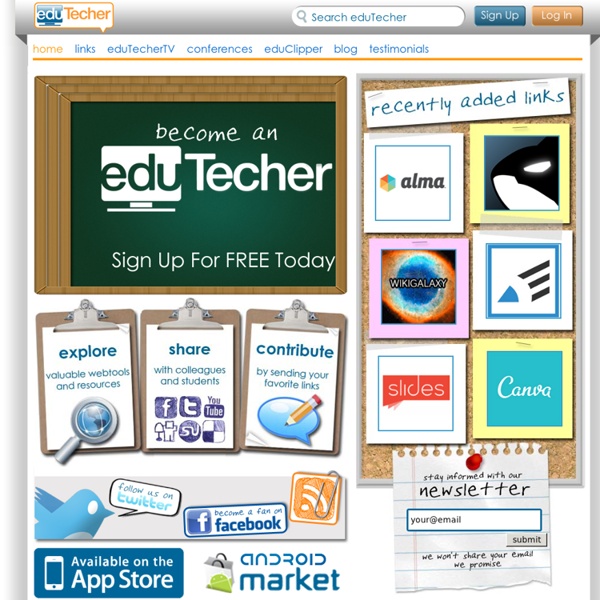



Khan Academy Google Tools Tutorials This page contains tutorials for using Google tools. The tutorials that I've created you are welcome to use in your own blog, website, or professional development session. Before using the tutorials created by others, please contact their creators. Google Docs for Teachers 2012 Google for Teachers Google for Teachers II - Google Earth Across the Curriculum - How to remove the Navigation Bar from Blogger Blogs. Google Voice. VoiceMail Transcription. Number porting in Google Voice. SMS to Email. Conference Calls. Make calls from your computer. Creating a blog using Blogger. Adding Static Pages to Blogger. Posting to your Blogger blog from your phone.
ContinYou - Changing lives through learning Jing, instant screenshots and screencasts, free tour page The always-ready program that allows you to instantly capture images and record video on your computer—then share them with anyone. Jing is a great tool for adding basic visual elements to all of your online conversations Jing for Screenshots Capture What You See The Jing sun sits nicely on your desktop, ready to capture your screen at a moment’s notice. Jing Loves to Share Send your screenshots all over the web. Make a Point Need to emphasize a point or explain a tricky concept? No Need to Wait Simply paste the link into an IM, email, forum post, anywhere…and when the person clicks it they see your freshly–uploaded screenshot. Share Images Instantly Jing will place a hyperlink on your clipboard when you send your screenshots to a destination like Screencast.com or Flickr. Jing for Screencasts Record What You See (and Do) Select any window or region that you would like to record, and Jing will capture everything that happens in that area. Instantly share Jing video on: Narrate on the Fly
Born to Learn ~ You are Born to Learn Professional Development in Technology I recently came across a blog by a Head of English in a school. It’s interesting to hear the views of a non-ICT specialist about what works or might work in getting teachers engaged. There are some very useful points made in the post entitled Professional Development in Schools: Listening to staff after PD, their number one complaint is about not getting time to play and make stuff with what they just learned This is absolutely correct in my experience. Make sure the project is based on something that can actually be used in the classroom (not just an excuse to try new tools) following a sound curriculum planning process. Something which ought not need to be said, but it’s all too often the case that people fall into the trap of pursuing gadgets and widgets for their own sake. Are lunch and learns the answer? On the other hand, I can see that lunch and learns are an attractive alternative to twilights and learns. Other articles you may find useful Ed Tech Leadership Issues
Students with Disabilities | Imagine Learning Five Key Components of Reading No more roadblocks to reading. Students with disabilities often struggle to acquire basic reading skills. Explicit instruction in phonological awareness phonics fluency vocabulary comprehension Vocabulary Development A better way to learn the lingo. Vocabulary knowledge directly influences comprehension, so students with disabilities who struggle with comprehension need all the extra vocabulary instruction they can get. Contextualized instruction in basic vocabulary academic vocabulary content-specific vocabulary Listening Comprehension Help students develop an ear for understanding. Many students with disabilities experience difficulty in processing language. Students learn through selective listening verbal and non-verbal cues specific words and phrases Speaking (Songs, Chants, Conversations) A real conversation starter. Students with disabilities may have a hard time expressing themselves or interacting with peers at school. Common Core Standards
12 Ways to Create Videos Without a Camera or Software It wasn't that long ago that creating videos in your classroom meant that you had to have access to cameras and editing software. That is no longer the case. Now with nothing more than a reliable Internet connection you and your students can create all kinds of documentary, entertainment, and how-to videos. Some of the resources listed below are also featured in my free guide Making Videos on the Web where you will find how-to directions with annotated screen captures. JayCut is a free, online, video editing service. To use JayCut online you will need to join the JayCut community. Masher is a great, free, tool for creating video mash-ups. Animoto makes it possible to quickly create a video using still images, music, and text. Flixtime is a video creation service that is quite similar to Animoto and Stupeflix. Photo Peach is a new service that allows you to quickly and easily create an audio slideshow, with captions, from images in your Flickr, Picassa, or Facebook account.
WebQuest.Org: Home e-Prints Soton - Learning and teaching using ICT in secondary sc Woollard, John (2007) Learning and teaching using ICT in secondary schools, Exeter, UK, Learning Matters Ltd, 192pp. (Achieving QTS). Download Full text not available from this repository. Description/Abstract This book supports secondary trainees, whatever their subject specialism, who wish to develop their knowledge and understanding of the ways in which ICT can enhance learning and teaching. It recognises the variety of contexts in which ICT is used and demonstrates the many ways in which it can support learning and teaching, both in the classroom and in the virtual worlds of school intranets, websites and learning platforms. The book is motivated by the conviction that ICT should be used as an effective tool for teaching and learning and not just for its own sake.
Повезан је са Едмодом by snata Feb 26